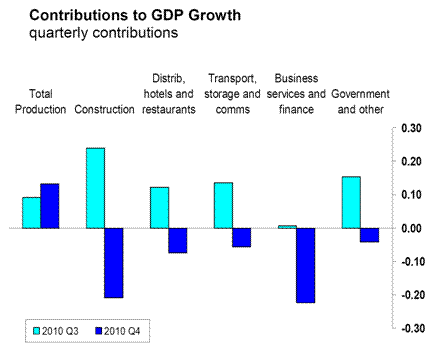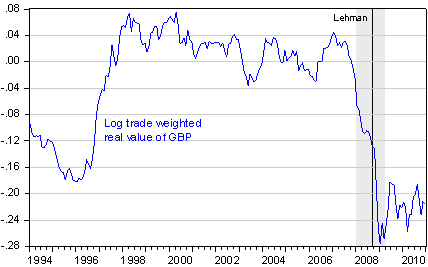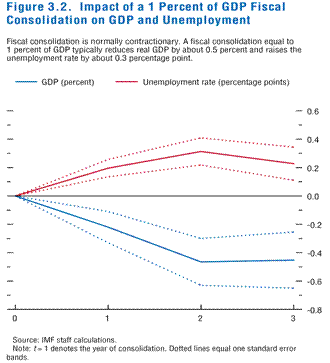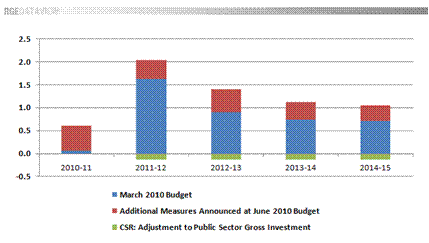The UK can be seen as a kind of test case for the proposition that contractionary fiscal policy can induce an economic expansion, a proposition forwarded by most recently Alesina and Ardana (2010) [wp version] (following up earlier work by Alesina and Perroti). So far, admittedly early in the process, the evidence is not consistent with the view of expansionary contraction. Here’s Gavyn Davies’ view:
…The statistics were expected to show a significant slowdown in output growth, but nothing like the drop of 0.5% in real GDP (-2 per cent quarter-on-quarter annualised) which was actually announced this morning. …
Davies provides a caveat:
…these figures seem much too bad to be true, and not just because of the weather. The underlying growth rate of private sector GDP probably remains at around +2 per cent on an annualised basis, and it would not be at all surprising to see a sharp rebound in recorded growth in the current quarter. Nevertheless, the recovery in the UK economy, while still intact, continues to run at a less impressive pace than we are seeing elsewhere in the developed world.
The UK Recovery (and Relapse?) in Perspective
Davies provides graph of UK and G7 output trends (normalized) provides some context. The graph provides the ONS’s estimate of output abstracting from the severe weather in December.

Figure 1: G7 and UK GDP normalized to 100 at 2007Q4. Source: G. Davies (2010).
This is a preliminary release, akin to the “advance” release for US GDP statistics, so one should be particularly cautious about overinterpreting. Nonetheless, best estimates are for zero growth in 2010Q4. Where does the fiscal retrenchment fit in? In line with the plan to cut government overall expenditures (spending as well as transfers), the contribution of government consumption to overall GDP growth is negative.

Figure 2: Contributions to UK GDP growth (q/q) in 2010Q3 and 2010Q4. Source: Office of National Statistics, 2010Q4 preliminary GDP release.
Note, that the -0.5% q/q growth rate is equivalent to approximately -2.0 q/q annualized growth. The -0.02 ppt q/q contribution of government spending is a substantial decrease from the approximately 0.16 ppts contribution in 2010Q3. Presumably, going forward, this will shift to an even bigger negative contribution.
Looking forward, most economists appear gloomy. From The Guardian Alan Clarke, UK economist at BNP Paribas observes:
…as the year progresses we expect the implementation of the government’s austerity measures to bite, reinforcing the headwinds to growth. More generally, the biggest question for 2011 growth is whether or not consumer spending will grow – especially with inflation running well in excess of income growth. We expect pedestrian consumer spending growth at best, which given it accounts for around two-thirds of GDP by expenditure, will set the tone for a sluggish overall growth rate.
Overall, a terrible headline reading, probably exacerbated by the weather. Nonetheless, weak even without the weather and likely to reinforce our below-consensus growth forecast for this year.
Alasdair Reisner, Civil Engineering Contractors Association predicts:
Sadly there seems to be little in the way of confidence that there will be a turnaround in the industry’s prospects in 2011, and with the full effect of public sector cuts yet to feed through, there may very well be further bad news to come in future quarters.
Mark Bolsom, Head of the UK trading desk at Travelex Global Business Payments concludeses:
We knew that snow had seriously impacted retail sales in December but this will come as a massive shock; nobody expected contraction.
It’s a real disaster, given that January’s VAT hike will drain even more money out of the system. And whilst there had been talk of an interest rate hike, this is surely now off the agenda. Quantitative easing is now back on the cards.
Economic contraction is a really bad way to go into a period of heavy fiscal tightening and is not what the government would have wanted at all. The chancellor may find himself having to defend his economic plans over the coming days.
The UK as a Small Open Economy
Fortunately for the UK, it has a floating exchange rate, which serves as a buffer in times of economic weakness.

Figure 3: Log real broad trade weighted value of the British pound. Gray shaded area denotes UK GDP peak to trough. Source: BIS.
The graph highlights the fact that the UK economy has already experienced a currency depreciation that has provided some relief.
Will the UK Avoid a Contraction? (i.e., is 2010Q4 a blip?)
If historical evidence is any guide, one should not expect a tremendous short run boom in response the the fiscal contraction. The last IMF World Economic Outlook (Chapter 3) assessed this issue in a systematic fashion, using a Romer and Romer (2010) narrative/action-based criterion to determine consolidation episodes, as opposed to examining changes in the cyclically adjusted primary budget balance (CAPB), used in Alesina and Ardagna (2010).
- Fiscal consolidation typically has a contractionary effect on output. A fiscal consolidation equal
to 1 percent of GDP typically reduces GDP by
about 0.5 percent within two years and raises
the unemployment rate by about 0.3 percentage
point. Domestic demand—consumption and
investment—falls by about 1 percent.
- Reductions in interest rates usually support
output during episodes of fiscal consolidation.
Central banks offset some of the contractionary
pressures by cutting policy interest rates, and
longer-term rates also typically decline, cushioning
the impact on consumption and investment.
For each 1 percent of GDP of fiscal consolidation,
interest rates usually fall by about 20 basis
points after two years. The model simulations
also imply that, if interest rates are near zero, the
effects of fiscal consolidation are more costly in
terms of lost output.
- A decline in the real value of the domestic currency
typically plays an important cushioning
role by spurring net exports and is usually due
to nominal depreciation or currency devaluation.
For each 1 percent of GDP of fiscal
consolidation, the value of the currency usually
falls by about 1.1 percent, and the contribution of net exports to GDP rises by about 0.5
percentage point. Because not all countries can
increase net exports at the same time, this finding
implies that fiscal contraction is likely to be
more painful when many countries adjust at the
same time.
- Fiscal contraction that relies on spending cuts
tends to have smaller contractionary effects than
tax-based adjustments. This is partly because
central banks usually provide substantially more
stimulus following a spending-based contraction
than following a tax-based contraction. Monetary
stimulus is particularly weak following indirect
tax hikes (such as the value-added tax, VAT) that
raise prices.
- Fiscal retrenchment in countries that face a
higher perceived sovereign default risk tends to
be less contractionary. However, even among
such high-risk countries, expansionary effects are
unusual.
- Model simulations suggest that over the long
term, reducing debt is likely to be beneficial.
In particular, the GIMF simulations considered
here suggest that lower government debt levels
reduce real interest rates, which stimulates
private investment. Also, the lower burden of
interest payments creates fiscal room for cutting
distortionary taxes. Both of these effects raise
output in the long term. Overall, the simulations
imply that for every 10 percentage point fall in
the debt-to-GDP ratio, output rises by about
1.4 percent in the long term.
Figure 3.2 from the IMF WEO shows the impact on GDP and unemployment.

Source: From Chapter 3 of IMF WEO, October 2010.
Note that the IMF estimates include the cushioning effects of exchange rate depreciation and net export increase (as well as offsetting stimulative monetary policy, something which is circumscribed for economies already at zero interest rates).
The Specifics of the UK Fiscal Plan
Returning to the UK experience, we shouldn’t be surprised, I think, to see a further negative readings in growth. Figure 2 from Mason and Walia (2010) shows the amount of planned fiscal consolidation.

Figure 2, Total Fiscal Consolidation (% of GDP), Her Majesty’s Treasury, OBR, RGE, from James Mason and Parul Walia, “More Than One Way to Skin a Cat: A Review of UK Fiscal Plans,” RGE Monitor (Jan 20, 2011).
They write of the government’s plan (“Plan A”):
Our main criticism of Plan A is that it is unnecessarily front-loaded in terms of cash impact, as opposed to policy approval. It is inevitable that hastily cobbled together measures to cut costs quickly will have a more detrimental impact on the economy (i.e. a higher fiscal multiplier) than more considered measures aimed at reducing long-term spending. Likewise, the severe cuts to capital expenditure and government investment will have a higher fiscal multiplier than reforms to long-term health provision or pension costs.
The Impact of Fiscal Austerity on Economic Growth
Based on a review of the literature described briefly below, we assumed a fiscal multiplier of 0.5 to estimate the impact on GDP growth from the fiscal consolidation (see Figure 4). That effectively assumes that the private sector picks up half of the slack left by the government pulling back.
RGE Monitor predicts output to be 0.3 percentage points of GDP lower in 2010-11, and 1 percentage point in 2011-12.
Simulations by the IMF using GIMF find that for a small open economy like Canada, fiscal contraction at a time when the rest-of-the-world is undertaking similar fiscal austerity measures roughly doubles the output loss (relative to an already increased loss when the zero interest constraint binds). The RGE Monitor estimates are based on the multipliers cited by Ethan Ilzetzki, Enrique G. Mendoza and Carlos A. Vegh [pdf] which do not account for the zero interest bound, so there is reason to believe they are understating the negative output impacts in the short run.
Concluding thought
In any case, regressions based on samples heavy on small open economies are unlikely to lead to conclusions terribly relevant to large, relatively closed economies like the US. A front loaded fiscal contraction in a much more closed economy such as the US would likely benefit much less from offsetting export-supported growth.
Postscript 1: An interesting methodological question, with a big impact on the end-results, is highlighted in Tables 3.4 and 3.5 in the WEO Chapter 3. One finds that the action-based criterion leads to many fewer episodes, particularly in small open economies (which have the luxury of greater depreciation to induce countervailing net export growth) than found using the Alesina and Ardagna (2010) approach.
Postscript 2: The IMF analysis spends some time on the discussing the differential impact of tax increases versus spending cuts. They posit this differential effect might be due to the monetary authorities reacting differently to each type of fiscal measure. To the extent that the interest rates are stuck at zero, the differential effects should be muted for the period that ZIRP holds.
Mark Bolsom has it right.
It’s a real disaster, given that January’s VAT hike will drain even more money out of the system. And whilst there had been talk of an interest rate hike, this is surely now off the agenda. Quantitative easing is now back on the cards.
The real disaster is that there is nothing in the plan to allow private businesses to recover. Consider yourself a businessman facing higher VAT taxes, interest rate hikes, and reduced government spending. Not a good formula for recovery and if you entertain any ideas of expansion you will not be in business long.
But sadly replacing interest rate hikes with quantitative easing is simply replacing one wedge to business recover with another. Prospects for any growth with these policies are certainly bleak.
Please some other phrase than that hideous “expansionary contraction” thing.
Nice post but it really is too early to say. My concern is that the pound’s depreciation already happened – and we see the strength of exports in the current numbers – which means there is little room for more adjustment, especially given Britain’s higher inflation. Imagine how bad things get if the pound goes up versus the euro.
I’m sorry, but lately Alesina has been something of an embarrassment to the economics profession in general and Harvard in particular. Why would anyone want to soil their reputation by collaborating with him? There was a time when I bothered to read his new working papers in NBER, but if I want goofy economics I prefer Casey Mulligan…just as crazy but without the complexity. Alesina’s papers just seem completely out of touch with reality and his war on Keynes is borderline solipsistic.
How does the UK’s ouput gap compare to the U.S.?
From the Guardian article –
And whilst there had been talk of an interest rate hike, this is surely now off the agenda.
I think the inflation rate is on the rise in the U.K., so it must be much narrower than the U.S. Otherwise, they would not have been talking about a rate hike. Correct?
Ah, expansionary contraction. As a result, the rest of the world is having a jobless recovery while we get the recovery of joblessness. Later, we may be going to hear about white blackness and cold heat. But how long is it before the living dead make their appearance?
The news just released that German unemployment has fallen to an 18 year low is instructive as we consider this thread. It was about a year ago that I mentioned that Merkel’s Germany was making the right moves while the US was making the wrong moves. It appears to be serious confirmation that Germany has made the right economic decisions since its unemployment rate has fallen to 7.2% the lowest since 1992.
Germany is in recovery even though it is having to deal with the EU economic problems.
Why does the US government persist in following failed policies?
I was thinking we do see expansionary contraction in one area: childbirth. Contraction pushes the baby along, the cervix effaces, there is expansion and voila you have a baby.
I don’t see how these two uses relate at all. It seems rather more likely the British people are experiencing the other end of the baby making process.
Informative post. I wish Fig. 3 went back a bit further.
Fig. 2 tells the story, but I’m afraid more people will be inclined to look at something like Fig. 1 and take the actual path of output after the contractionary fiscal policy to be the effect of the policy, without paying much attention to the counterfactual.
Nominal GDP growth in the UK was running at above a 5% pace in the three quarters preceding fiscal austerity. That’s not good enough to bring it back to trend but it was better than the US. It slowed to 3.6% in 2010 Q3 and was probably about the same in the fourth quarter (we don’t know because the UK Office of National Statistics hasn’t released those numbers yet).
Perhaps what the BOE needs to do is loosen monetary policy further to compensate for the fiscal austerity. The Bank Rate is still 0.5% so it could be lowered and there’s always the option of expanding asset purchases (currently at 200 billion pounds). But given that the CPI rose 3.7% in the last year there probably would be resistance to that.
And all of this begs the following question. Why has real growth been so weak in the UK? It’s beginning to look like a little case of stagflation. In most of the advanced nations inflation is lower and real growth higher. What’s going on in the UK?
jonathan: I agree it’s too early to conclude — what I was trying to stress is (1) fantasies about rational expectations combined with anticipated debt/gdp stabilization inducing growth are just fantasies, and (2) the empirical evidence is not encouraging.
tj: December 2010 OECD Economic Outlook projects 2011 output gap as 4% for UK, 3% for US. I think you should not look only at the output gap; you can get inflation also via a depreciated currency, if there is substantial exchange rate pass through into CPI, or if you are highly energy dependent, and energy prices rise substantially (I think this might pertain to Mark A. Sadowski‘s question).
Ricardo: Don’t suppose you happened to look at Figure 1. You’ll note that Germany is at the same level of GDP vis a vis 2007Q4 as the US, despite having implemented what you say are laudable fiscal measures. In addition, I’d say Germany has benefitted from Euro area problems, to the extent that the sovereign debt issues have depreciated the euro.
don: You can get a longer British series off the BoE website; or the narrow series off of the BIS website. If you have access to IMF IFS database, that’s another way to get a longer series.
Also, Germany didn’t implement “virtue”, it did a €50bn immediate fiscal stimulus and bailed out a bunch of banks, then followed up with a second round of stimulus and then a package of expansionary tax cuts. There’s a reason why it was a German who said Erst kommt das Fressen, dann kommt die Moral.
I can also remember quite a lot of right-wing pundits lecturing back in 2008-2009 that the Anglo-Saxon economies were weathering the crisis better than the Germans and their silly dated export industries and social partnership and whatnot. We suddenly don’t hear so much of this. I wonder what happened?
Menzie,
You are correct about GDP but I use GDP very carefully as an indicator. GDP is based on Keynesian theory of including government spending as government investment (Obama’s agreement with Keynesian theory) replacing private spending.
My point is about unemployment, where the rubber meets the road. The US is following policies that shift the GDP mix from the private sector to government. Germany is following policies that are shifting the GDP mix from the state to the private sector. Aggregates tend to obscure this.
Germany has engaged in reducing government spending, just as has been suggested in the UK, but Germany also cut taxes while the UK is increasing taxes.
Cutting government spending and taxes allows the private sector to take over those services that government was running inefficiently. The private sector improves both the quality and the return on the service turning from a cost, as these services are under government, to a return with the private sector making a profit and paying taxes. In this event the government both reduces cost and receives more revenue. This was the one of the most important things Bill Clinton did in the 1990s when he signed welfare reform. He moved those on welfare to producers, that reduced government expense and increased goods and tax revenue.
But in a situation where the government cuts cost and raises taxes we see the services disappear but the private sector is strangled to the point that it cannot pickup the reduced services. That is a recipe for disaster.
It is just this kind of thinking that the Republicans must change. They are thinking budget cuts, but we have not seen any proposals for changes that will actually free the private sector.
I am not hopeful for the UK because they do not seem to understand this dynamic. I also fear for the US for the same reason. It seems that in the US it doesn’t matter whether Democrats or Republicans are in power they are going make things worse: Democrats by destoying the private sector with government taking over services and increasing cost, and the Republicans by simply killing the Democrats bureaucracy without any replacement for those dependent on those services.